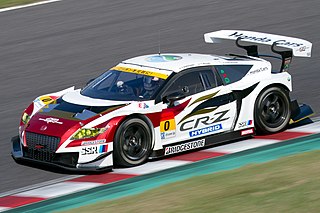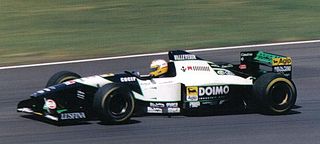
The Formula 3000 International Championship was a motor racing series created by the Fédération Internationale de l'Automobile (FIA) in 1985 to become the final preparatory step for drivers hoping to enter Formula One. Formula Two had become too expensive, and was dominated by works-run cars with factory engines; the hope was that Formula 3000 would offer quicker, cheaper, more open racing. The series began as an open specification, then tyres were standardized from 1986 onwards, followed by engines and chassis in 1996. The series ran annually until 2004, and was replaced in 2005 by the GP2 Series.
Arrows Grand Prix International was a British Formula One team active from 1978 to 2002. It was known as Footwork from 1991 to 1996.
Marco Apicella is an Italian former professional racing driver. He competed in one Formula One Grand Prix for the Jordan team in the 1993 Italian Grand Prix. He later won the 1994 Japanese Formula 3000 Championship driving for Dome.

The 1995 FIA Formula One World Championship was the 49th season of FIA Formula One motor racing. It featured the 1995 Formula One World Championship for Drivers and the 1995 Formula One World Championship for Constructors, which were contested concurrently over a seventeen-race series that commenced on 26 March and ended on 12 November. Michael Schumacher won his second consecutive Drivers' Championship, and Benetton won the Constructors' Championship, the first and only Constructors' title for the Benetton team.

Shinji Nakano is a Japanese professional racing driver.

Esteban Eduardo Tuero is an Argentine former racing driver who raced in Formula One for the Minardi team in 1998. At 19, he became the then-third-youngest Formula One driver in history when he landed his seat alongside Shinji Nakano, but left the championship at the end of the season.

M-TEC Company, Ltd., doing business as Mugen Motorsports (無限), is a Japanese company formed in 1973 by Hirotoshi Honda, the son of Honda Motor Company founder Soichiro Honda, and Masao Kimura. Mugen, meaning "without limit", "unlimited" or "vast", is an engine tuner and parts manufacturer that manufactures OEM parts such as body kits and sports exhausts for Honda. Despite the family relationship, however, Mugen is not, and has never been, owned by Honda Motor Company; Mugen owner Hirotoshi Honda has been the biggest shareholder in Honda since his father's death in 1991.
The Lotus 112 was the proposed 1995 Formula One car of Team Lotus.
Dome Co. Ltd, literally "child's dream", is a Japanese racing car constructor involved mainly in open-wheel and sports car racing.

The Minardi M198 was the car with which the Minardi Formula One team used to compete in the 1998 FIA Formula One World Championship.

The Lola T97/30 was the car with which the MasterCard Lola Formula One team attempted to compete in the 1997 Formula One season. It was driven by Vincenzo Sospiri, the 1995 Formula 3000 champion, and Ricardo Rosset, who moved from Footwork. However, the team's tenure in F1 was brief. The first Lola chassis to compete in the sport since 1993 was originally planned for the 1998 season. However, due to pressure from main sponsor MasterCard, the car was rushed into service a year before the initial plan. The T9730 was not a success failing to qualify with either Sospiri or Rosset at its only attempt(s) which was the opening round of the 1997 season at the 1997 Australian Grand Prix before the team and cars were withdrawn from the next race in Brazil. Neither the T97/30 or the team would been seen again competing at a Grand Prix thereafter as Lola withdrew from the 1997 championship due to financial and technical difficulties having only competed in one race weekend. As of September 2023, the T97/30 is last Lola chassis to compete at Formula One World Championship Grand Prix weekend.

Asiatech was the trade name of Asia Motor Technologies France, a company founded in 2000 by Japanese private capital under the leadership of Dr. John Gano and Enrique Scalabroni, which purchased the assets of the Peugeot Formula One programme at the end of the 2000 season. Its mandate was to acquire top-level European engine technology for Asia and to create an Asian-themed F1 team. It increased staffing from 170 to 221 employees, supplied its engines in development for testing at no cost to minor teams in 2001 and 2002, and had designed and presented the wind-tunnel model of its original F1 chassis when its Japanese private funding was cut in 2002. Asiatech returned the staff and facilities it had acquired back to Peugeot and wound down at the end of the 2002 season.

The Minardi M195 was a Formula One car designed by Aldo Costa for the Minardi team. The original M195 was used in the 1995 Formula One World Championship while an updated version, the M195B, was used in the 1996 Championship. Both versions were powered by the Ford ED 3-litre V8 engine. Across its two seasons of racing the car was driven by Italians Pierluigi Martini, Luca Badoer, Giancarlo Fisichella and Giovanni Lavaggi, Portuguese Pedro Lamy and Brazilian Tarso Marques.

The Honda RA099 was a prototype Formula One racecar, commissioned by Honda, designed by ex-Ferrari and Tyrrell designer Harvey Postlethwaite and built by Dallara in 1999. Its purpose was similar to the one surrounding the Toyota TF101 of 2001, in that it was supposed to be a working test car used in preparation for a full-scale assault on Grand Prix racing in the following years.

The Honda RC100 was a prototype Formula One car built by engineers from Honda R&D Center, Tochigi, although not as an official project of Honda. The car was completed in 1993 and initially tested at Honda's Suzuka Circuit. Two more cars, known as RC101 and RC101B, were also built and tested before the project ended.

Équipe Ligier is a motorsport team, best known for its Formula One team that operated from 1976 to 1996. The team was founded in 1968 by former French rugby union player Guy Ligier as a sports car manufacturer.

The DAMS GD-01 was an unraced Formula One car used by the French motorsport team, Driot-Arnoux Motor Sport (DAMS). The GD-01 was designed and built by a collaboration of DAMS and Reynard engineers from 1994 to 1995, and was intended to establish the team—which had achieved considerable success in lower categories—in Formula One (F1), the premier Fédération Internationale de l'Automobile (FIA)-sanctioned level of racing. However, due to insufficient financial backing, the team never entered the championship, despite completing construction of the chassis and conducting limited testing.
The Subaru 1235 was a motor racing engine designed and built by Motori Moderni, and funded by Subaru for the Japanese manufacturer’s Formula One program in 1990. A 3.5-litre boxer-12, it was used by the Coloni team for the first eight races, but proved to be very unsuccessful and the team reverted to using the old Cosworth DFR V8 engine. Alba also used it in the World Sportscar Championship in 1990, but were similarly unsuccessful and switched to a 4.5-litre Buick V6 midway through the season.
Honda has been competing in a variety of racing series through the years, including Formula One, IndyCar, touring car racing, sports car racing and MotoGP. Currently they are involved in Formula One, MotoGP, Super GT, Super Formula, IndyCar, IMSA, BTCC, TC2000, Formula 3, Formula 4, off-road, WSBK, EWC, MXGP, TrialGP and various different GT3 and TCR series. All of Honda's motorsport activities are managed by Honda Racing Corporation (HRC).

The RA series of 3.5-litre and 3.0-litre, naturally-aspirated, V10 racing engines were made by Honda to compete in Formula One racing; between 1989 and 1990, and then again between 2000 and 2005. Between 1992 and 2000, the engines were also made by Mugen Honda. The customer engines were used by McLaren, Arrows, Lotus, Ligier, Tyrrell, Prost, and Jordan.














